Report on Cervical Cancer Screening for Australian Population
VerifiedAdded on 2022/12/26
|6
|1574
|39
Report
AI Summary
This report examines cervical cancer, a significant health issue, focusing on its screening program, the Pap test, within the Australian context. The introduction highlights the prevalence of cervical cancer, emphasizing the role of HPV and sexually transmitted infections. It delves into the risk factors associated with cervical cancer, including HPV infection, weakened immune systems, genital herpes, and smoking. The report then explores health promotion strategies that nurses can employ to reduce the risk of cervical cancer, such as providing education, promoting healthy lifestyles, and encouraging the use of condoms. It then analyzes the Pap screening program's benefits for the Australian population, detailing its effectiveness in early detection. Finally, the report identifies barriers to screening faced by the Western Australian population, including financial constraints, lack of information, and cultural factors, concluding that these barriers must be addressed to improve screening rates and reduce cervical cancer incidence.
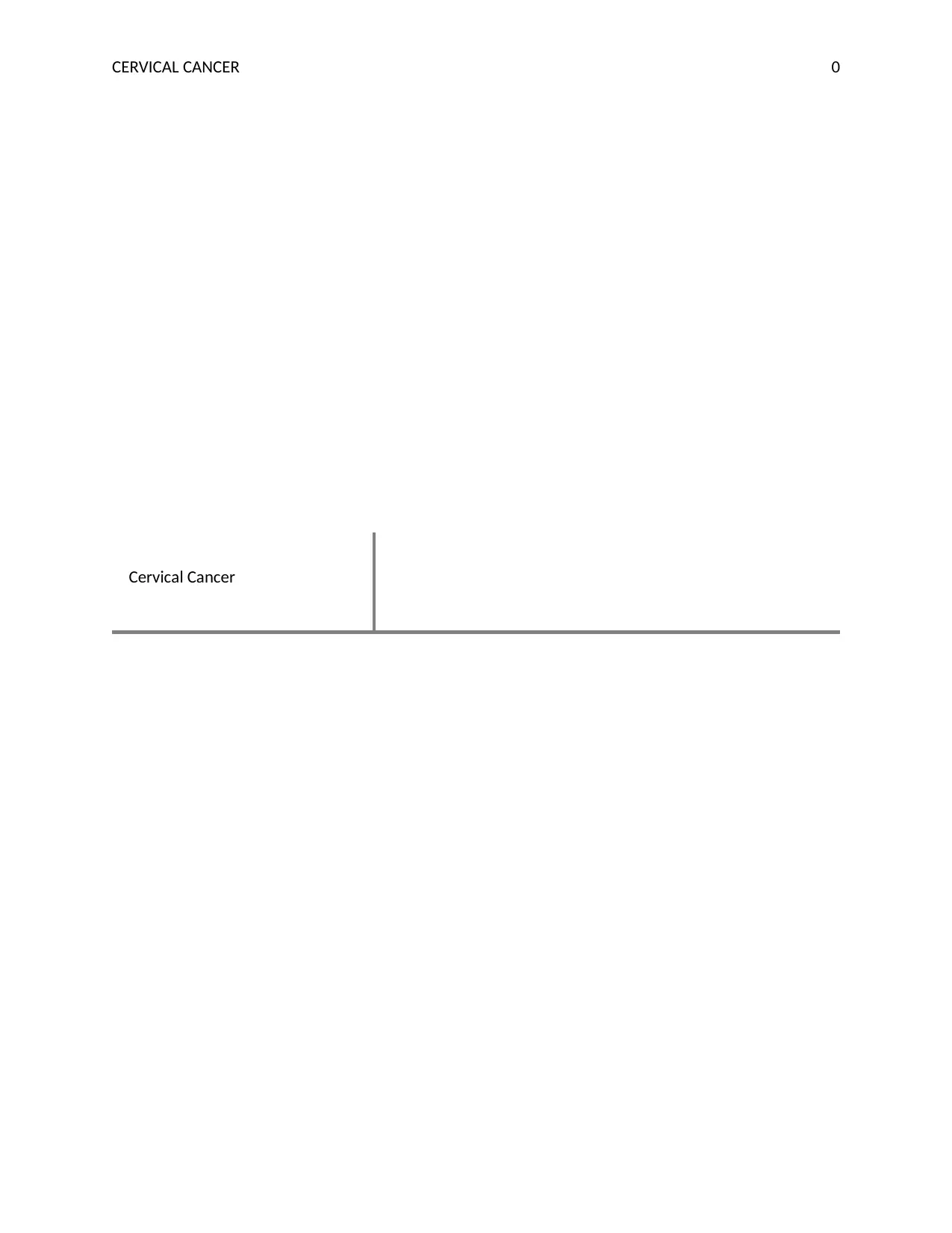
CERVICAL CANCER 0
Cervical Cancer
Cervical Cancer
Paraphrase This Document
Need a fresh take? Get an instant paraphrase of this document with our AI Paraphraser
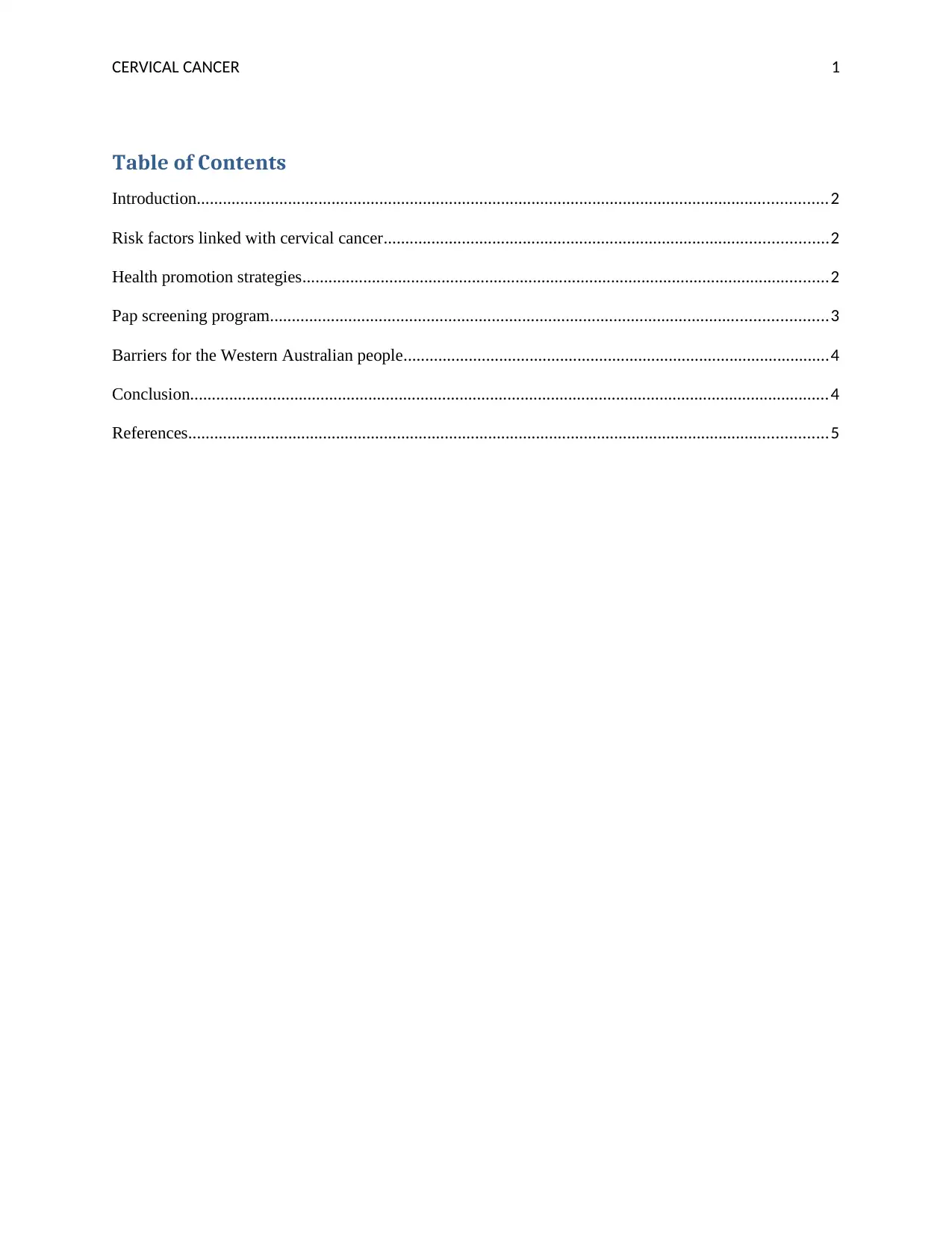
CERVICAL CANCER 1
Table of Contents
Introduction.................................................................................................................................................2
Risk factors linked with cervical cancer......................................................................................................2
Health promotion strategies.........................................................................................................................2
Pap screening program................................................................................................................................3
Barriers for the Western Australian people..................................................................................................4
Conclusion...................................................................................................................................................4
References...................................................................................................................................................5
Table of Contents
Introduction.................................................................................................................................................2
Risk factors linked with cervical cancer......................................................................................................2
Health promotion strategies.........................................................................................................................2
Pap screening program................................................................................................................................3
Barriers for the Western Australian people..................................................................................................4
Conclusion...................................................................................................................................................4
References...................................................................................................................................................5
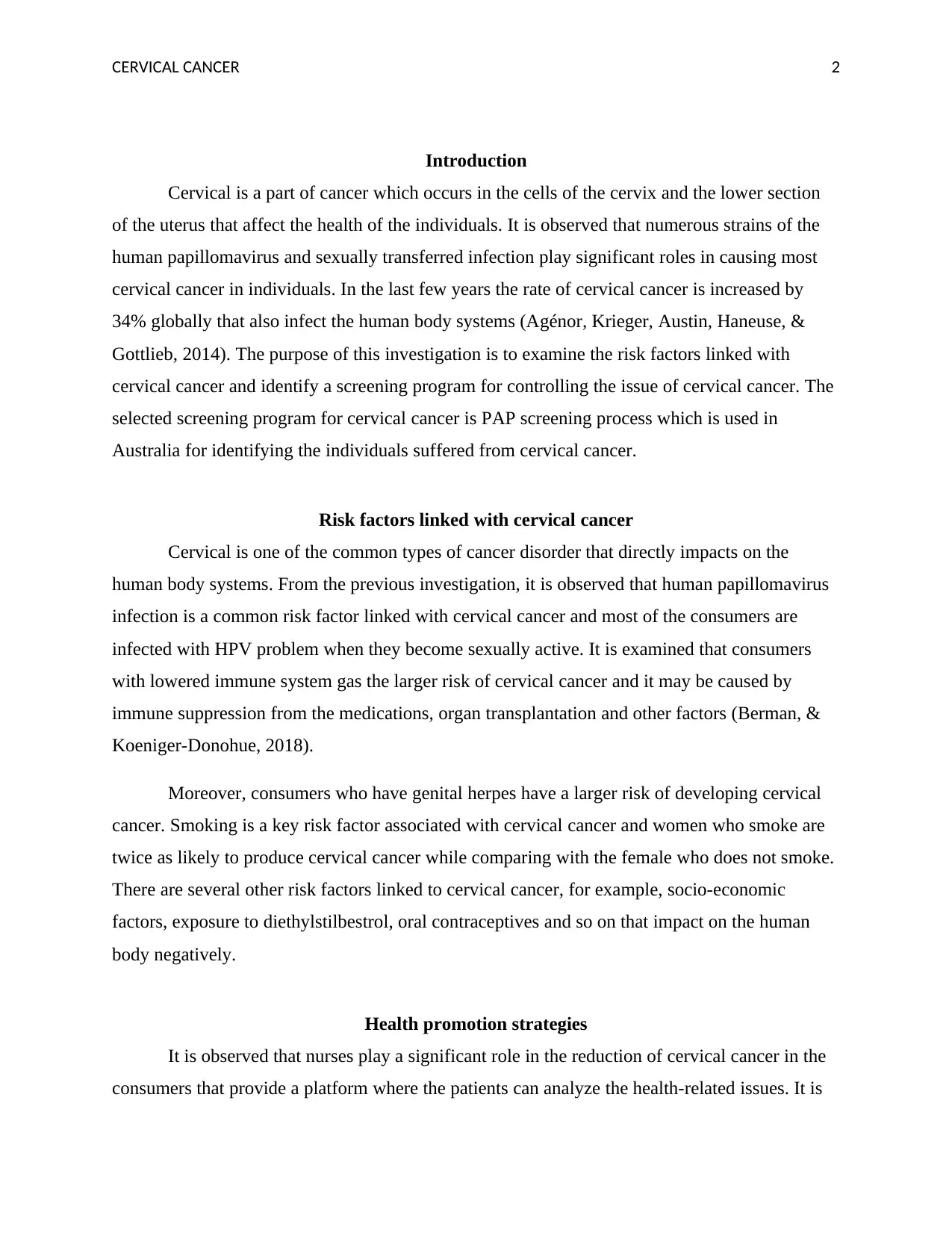
CERVICAL CANCER 2
Introduction
Cervical is a part of cancer which occurs in the cells of the cervix and the lower section
of the uterus that affect the health of the individuals. It is observed that numerous strains of the
human papillomavirus and sexually transferred infection play significant roles in causing most
cervical cancer in individuals. In the last few years the rate of cervical cancer is increased by
34% globally that also infect the human body systems (Agénor, Krieger, Austin, Haneuse, &
Gottlieb, 2014). The purpose of this investigation is to examine the risk factors linked with
cervical cancer and identify a screening program for controlling the issue of cervical cancer. The
selected screening program for cervical cancer is PAP screening process which is used in
Australia for identifying the individuals suffered from cervical cancer.
Risk factors linked with cervical cancer
Cervical is one of the common types of cancer disorder that directly impacts on the
human body systems. From the previous investigation, it is observed that human papillomavirus
infection is a common risk factor linked with cervical cancer and most of the consumers are
infected with HPV problem when they become sexually active. It is examined that consumers
with lowered immune system gas the larger risk of cervical cancer and it may be caused by
immune suppression from the medications, organ transplantation and other factors (Berman, &
Koeniger-Donohue, 2018).
Moreover, consumers who have genital herpes have a larger risk of developing cervical
cancer. Smoking is a key risk factor associated with cervical cancer and women who smoke are
twice as likely to produce cervical cancer while comparing with the female who does not smoke.
There are several other risk factors linked to cervical cancer, for example, socio-economic
factors, exposure to diethylstilbestrol, oral contraceptives and so on that impact on the human
body negatively.
Health promotion strategies
It is observed that nurses play a significant role in the reduction of cervical cancer in the
consumers that provide a platform where the patients can analyze the health-related issues. It is
Introduction
Cervical is a part of cancer which occurs in the cells of the cervix and the lower section
of the uterus that affect the health of the individuals. It is observed that numerous strains of the
human papillomavirus and sexually transferred infection play significant roles in causing most
cervical cancer in individuals. In the last few years the rate of cervical cancer is increased by
34% globally that also infect the human body systems (Agénor, Krieger, Austin, Haneuse, &
Gottlieb, 2014). The purpose of this investigation is to examine the risk factors linked with
cervical cancer and identify a screening program for controlling the issue of cervical cancer. The
selected screening program for cervical cancer is PAP screening process which is used in
Australia for identifying the individuals suffered from cervical cancer.
Risk factors linked with cervical cancer
Cervical is one of the common types of cancer disorder that directly impacts on the
human body systems. From the previous investigation, it is observed that human papillomavirus
infection is a common risk factor linked with cervical cancer and most of the consumers are
infected with HPV problem when they become sexually active. It is examined that consumers
with lowered immune system gas the larger risk of cervical cancer and it may be caused by
immune suppression from the medications, organ transplantation and other factors (Berman, &
Koeniger-Donohue, 2018).
Moreover, consumers who have genital herpes have a larger risk of developing cervical
cancer. Smoking is a key risk factor associated with cervical cancer and women who smoke are
twice as likely to produce cervical cancer while comparing with the female who does not smoke.
There are several other risk factors linked to cervical cancer, for example, socio-economic
factors, exposure to diethylstilbestrol, oral contraceptives and so on that impact on the human
body negatively.
Health promotion strategies
It is observed that nurses play a significant role in the reduction of cervical cancer in the
consumers that provide a platform where the patients can analyze the health-related issues. It is
⊘ This is a preview!⊘
Do you want full access?
Subscribe today to unlock all pages.

Trusted by 1+ million students worldwide

CERVICAL CANCER 3
suggested that nurses should provide proper intervention programs and practices for addressing
the issue of cervical cancer (Blatt, Kennedy, Luff, Austin, & Rabin, 2015). Nurses can motivate
patients by providing information about the impacts and causes of cervical cancer.
It is observed that avoiding smoking is an effective promotion strategy which can be used
by the nurses and promote healthy diets to the patients suffering from cervical cancer. Moreover,
nurses can explain and elaborate on the risk factors linked with cervical cancer and promote the
utilization of condoms in order to reduce the impacts of cervical cancer on the human body.
Gage, et al., (2014) examined that nurses should implement cervical screening test on the
patients suffering from cervical cancer and provide proper vaccines to the patients that can
protect the individuals from the HPV infection along with cervical cancer. Therefore, it is stated
that using all these health promotion strategies the nurses can control and manage the risk of
cervical cancer in the patients (Nayar, & Wilbur, 2015).
Pap screening program
It is one of the best screening programs for cervical cancer which is used in Australia for
identifying the individuals who are suffering from the issue of cervical cancer. In the year 2017,
the cervical screening test is replaced by the Pap test in Australia for effectively screening the
patients linked with cervical cancer. A Pap smear is also known as a Pap test which is a kind of
process that has the ability for managing the rate of cervical cancer in the Australian population.
A recent study reported that Pap test includes obtaining cells from the cervix and narrow end of
the women uterus (Peitzmeier, Khullar, Reisner, & Potter, 2014).
It is more effective and beneficial for the Australian population because of their ability to
screen the consumers for cervical cancer. It is argued that the Pap test is mainly done in
conjunction with a pelvic process and in Australia, most of the health care systems use this
process for screening the patients for treatments and intervention programs. Therefore, it is stated
that in Australian population Pap test can be used and beneficial because of their ability to screen
the patients in an effective manner and also provide better screening services to the health care
providers.
suggested that nurses should provide proper intervention programs and practices for addressing
the issue of cervical cancer (Blatt, Kennedy, Luff, Austin, & Rabin, 2015). Nurses can motivate
patients by providing information about the impacts and causes of cervical cancer.
It is observed that avoiding smoking is an effective promotion strategy which can be used
by the nurses and promote healthy diets to the patients suffering from cervical cancer. Moreover,
nurses can explain and elaborate on the risk factors linked with cervical cancer and promote the
utilization of condoms in order to reduce the impacts of cervical cancer on the human body.
Gage, et al., (2014) examined that nurses should implement cervical screening test on the
patients suffering from cervical cancer and provide proper vaccines to the patients that can
protect the individuals from the HPV infection along with cervical cancer. Therefore, it is stated
that using all these health promotion strategies the nurses can control and manage the risk of
cervical cancer in the patients (Nayar, & Wilbur, 2015).
Pap screening program
It is one of the best screening programs for cervical cancer which is used in Australia for
identifying the individuals who are suffering from the issue of cervical cancer. In the year 2017,
the cervical screening test is replaced by the Pap test in Australia for effectively screening the
patients linked with cervical cancer. A Pap smear is also known as a Pap test which is a kind of
process that has the ability for managing the rate of cervical cancer in the Australian population.
A recent study reported that Pap test includes obtaining cells from the cervix and narrow end of
the women uterus (Peitzmeier, Khullar, Reisner, & Potter, 2014).
It is more effective and beneficial for the Australian population because of their ability to
screen the consumers for cervical cancer. It is argued that the Pap test is mainly done in
conjunction with a pelvic process and in Australia, most of the health care systems use this
process for screening the patients for treatments and intervention programs. Therefore, it is stated
that in Australian population Pap test can be used and beneficial because of their ability to screen
the patients in an effective manner and also provide better screening services to the health care
providers.
Paraphrase This Document
Need a fresh take? Get an instant paraphrase of this document with our AI Paraphraser
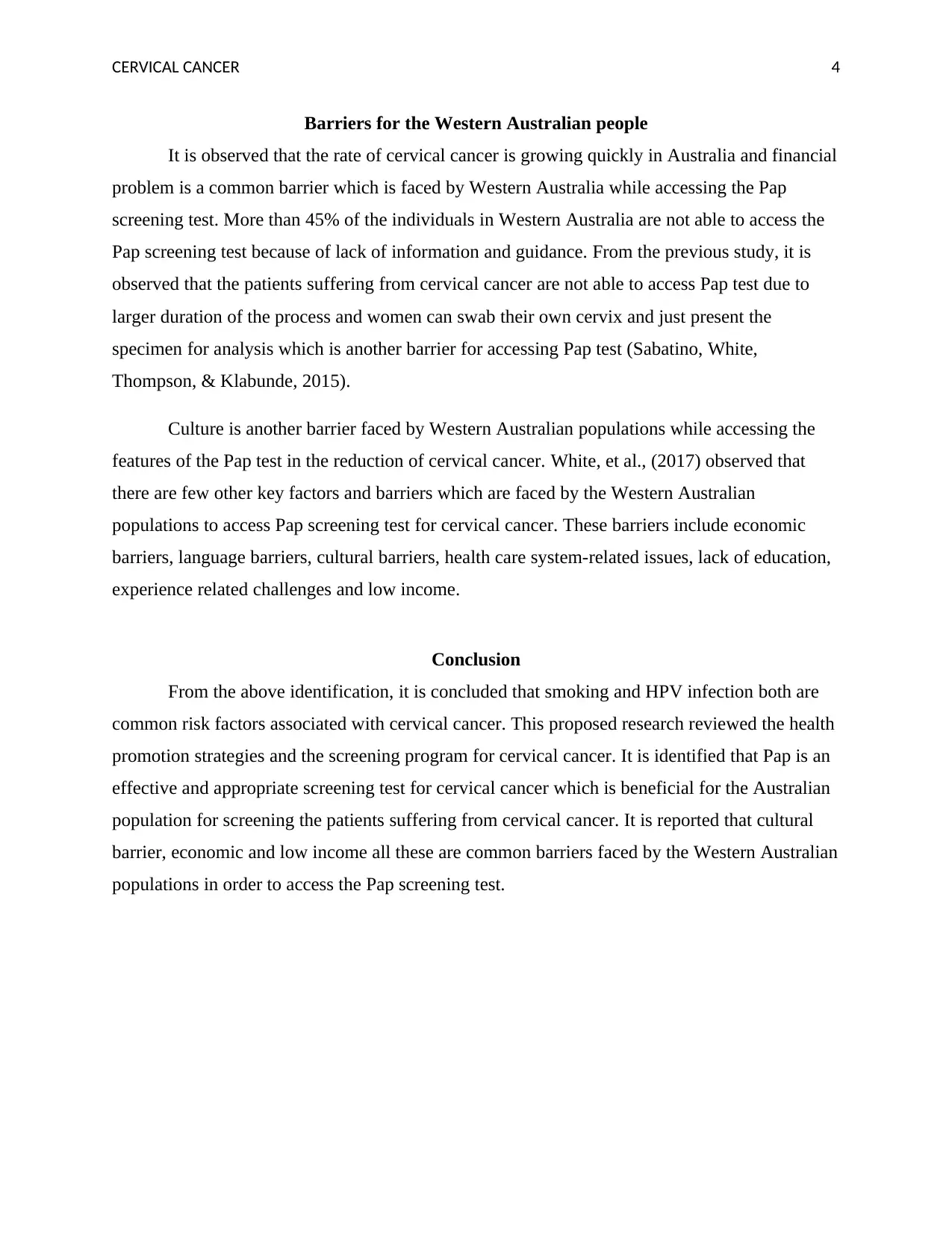
CERVICAL CANCER 4
Barriers for the Western Australian people
It is observed that the rate of cervical cancer is growing quickly in Australia and financial
problem is a common barrier which is faced by Western Australia while accessing the Pap
screening test. More than 45% of the individuals in Western Australia are not able to access the
Pap screening test because of lack of information and guidance. From the previous study, it is
observed that the patients suffering from cervical cancer are not able to access Pap test due to
larger duration of the process and women can swab their own cervix and just present the
specimen for analysis which is another barrier for accessing Pap test (Sabatino, White,
Thompson, & Klabunde, 2015).
Culture is another barrier faced by Western Australian populations while accessing the
features of the Pap test in the reduction of cervical cancer. White, et al., (2017) observed that
there are few other key factors and barriers which are faced by the Western Australian
populations to access Pap screening test for cervical cancer. These barriers include economic
barriers, language barriers, cultural barriers, health care system-related issues, lack of education,
experience related challenges and low income.
Conclusion
From the above identification, it is concluded that smoking and HPV infection both are
common risk factors associated with cervical cancer. This proposed research reviewed the health
promotion strategies and the screening program for cervical cancer. It is identified that Pap is an
effective and appropriate screening test for cervical cancer which is beneficial for the Australian
population for screening the patients suffering from cervical cancer. It is reported that cultural
barrier, economic and low income all these are common barriers faced by the Western Australian
populations in order to access the Pap screening test.
Barriers for the Western Australian people
It is observed that the rate of cervical cancer is growing quickly in Australia and financial
problem is a common barrier which is faced by Western Australia while accessing the Pap
screening test. More than 45% of the individuals in Western Australia are not able to access the
Pap screening test because of lack of information and guidance. From the previous study, it is
observed that the patients suffering from cervical cancer are not able to access Pap test due to
larger duration of the process and women can swab their own cervix and just present the
specimen for analysis which is another barrier for accessing Pap test (Sabatino, White,
Thompson, & Klabunde, 2015).
Culture is another barrier faced by Western Australian populations while accessing the
features of the Pap test in the reduction of cervical cancer. White, et al., (2017) observed that
there are few other key factors and barriers which are faced by the Western Australian
populations to access Pap screening test for cervical cancer. These barriers include economic
barriers, language barriers, cultural barriers, health care system-related issues, lack of education,
experience related challenges and low income.
Conclusion
From the above identification, it is concluded that smoking and HPV infection both are
common risk factors associated with cervical cancer. This proposed research reviewed the health
promotion strategies and the screening program for cervical cancer. It is identified that Pap is an
effective and appropriate screening test for cervical cancer which is beneficial for the Australian
population for screening the patients suffering from cervical cancer. It is reported that cultural
barrier, economic and low income all these are common barriers faced by the Western Australian
populations in order to access the Pap screening test.
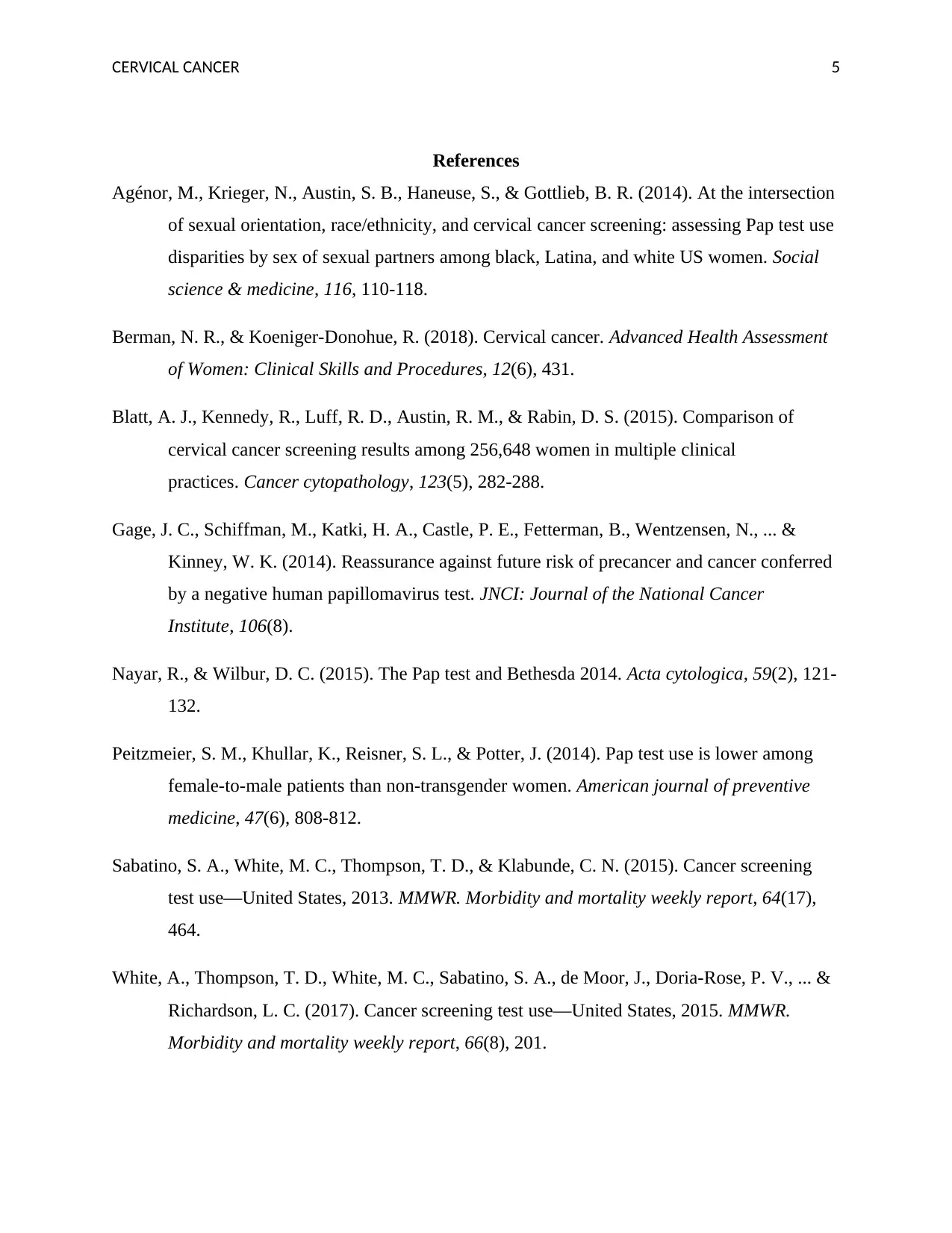
CERVICAL CANCER 5
References
Agénor, M., Krieger, N., Austin, S. B., Haneuse, S., & Gottlieb, B. R. (2014). At the intersection
of sexual orientation, race/ethnicity, and cervical cancer screening: assessing Pap test use
disparities by sex of sexual partners among black, Latina, and white US women. Social
science & medicine, 116, 110-118.
Berman, N. R., & Koeniger-Donohue, R. (2018). Cervical cancer. Advanced Health Assessment
of Women: Clinical Skills and Procedures, 12(6), 431.
Blatt, A. J., Kennedy, R., Luff, R. D., Austin, R. M., & Rabin, D. S. (2015). Comparison of
cervical cancer screening results among 256,648 women in multiple clinical
practices. Cancer cytopathology, 123(5), 282-288.
Gage, J. C., Schiffman, M., Katki, H. A., Castle, P. E., Fetterman, B., Wentzensen, N., ... &
Kinney, W. K. (2014). Reassurance against future risk of precancer and cancer conferred
by a negative human papillomavirus test. JNCI: Journal of the National Cancer
Institute, 106(8).
Nayar, R., & Wilbur, D. C. (2015). The Pap test and Bethesda 2014. Acta cytologica, 59(2), 121-
132.
Peitzmeier, S. M., Khullar, K., Reisner, S. L., & Potter, J. (2014). Pap test use is lower among
female-to-male patients than non-transgender women. American journal of preventive
medicine, 47(6), 808-812.
Sabatino, S. A., White, M. C., Thompson, T. D., & Klabunde, C. N. (2015). Cancer screening
test use—United States, 2013. MMWR. Morbidity and mortality weekly report, 64(17),
464.
White, A., Thompson, T. D., White, M. C., Sabatino, S. A., de Moor, J., Doria-Rose, P. V., ... &
Richardson, L. C. (2017). Cancer screening test use—United States, 2015. MMWR.
Morbidity and mortality weekly report, 66(8), 201.
References
Agénor, M., Krieger, N., Austin, S. B., Haneuse, S., & Gottlieb, B. R. (2014). At the intersection
of sexual orientation, race/ethnicity, and cervical cancer screening: assessing Pap test use
disparities by sex of sexual partners among black, Latina, and white US women. Social
science & medicine, 116, 110-118.
Berman, N. R., & Koeniger-Donohue, R. (2018). Cervical cancer. Advanced Health Assessment
of Women: Clinical Skills and Procedures, 12(6), 431.
Blatt, A. J., Kennedy, R., Luff, R. D., Austin, R. M., & Rabin, D. S. (2015). Comparison of
cervical cancer screening results among 256,648 women in multiple clinical
practices. Cancer cytopathology, 123(5), 282-288.
Gage, J. C., Schiffman, M., Katki, H. A., Castle, P. E., Fetterman, B., Wentzensen, N., ... &
Kinney, W. K. (2014). Reassurance against future risk of precancer and cancer conferred
by a negative human papillomavirus test. JNCI: Journal of the National Cancer
Institute, 106(8).
Nayar, R., & Wilbur, D. C. (2015). The Pap test and Bethesda 2014. Acta cytologica, 59(2), 121-
132.
Peitzmeier, S. M., Khullar, K., Reisner, S. L., & Potter, J. (2014). Pap test use is lower among
female-to-male patients than non-transgender women. American journal of preventive
medicine, 47(6), 808-812.
Sabatino, S. A., White, M. C., Thompson, T. D., & Klabunde, C. N. (2015). Cancer screening
test use—United States, 2013. MMWR. Morbidity and mortality weekly report, 64(17),
464.
White, A., Thompson, T. D., White, M. C., Sabatino, S. A., de Moor, J., Doria-Rose, P. V., ... &
Richardson, L. C. (2017). Cancer screening test use—United States, 2015. MMWR.
Morbidity and mortality weekly report, 66(8), 201.
⊘ This is a preview!⊘
Do you want full access?
Subscribe today to unlock all pages.

Trusted by 1+ million students worldwide
1 out of 6
Related Documents
Your All-in-One AI-Powered Toolkit for Academic Success.
+13062052269
info@desklib.com
Available 24*7 on WhatsApp / Email
![[object Object]](/_next/static/media/star-bottom.7253800d.svg)
Unlock your academic potential
Copyright © 2020–2025 A2Z Services. All Rights Reserved. Developed and managed by ZUCOL.





